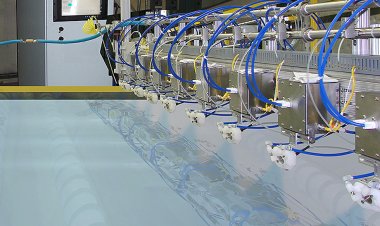Commercial Seaweed Market Size to Reach $10.8 Billion at a CAGR of 2.1% by 2028
Commercial seaweed market is projected to reach a value of USD 10.8 Billion by 2028 at a CAGR of 2.1% over the forecast period.

The Global Commercial Seaweed Market is valued at USD 9.6 Billion in 2021. The commercial seaweed industry is projected to reach a value of USD 10.8 Billion by 2028 at a CAGR of 2.1% over the forecast period.
The commercial seaweed market has been experiencing significant growth in recent years, driven by increasing demand for seaweed as a food ingredient, growing popularity of seaweed-based products, and rising awareness about the health benefits of seaweed consumption.
Click To Get a Free Sample On the Research Study @ https://www.vantagemarketresearch.com/commercial-seaweed-market-2000/request-sample
The food and beverage industry is the largest consumer of seaweed, using it as a natural thickener, stabilizer, and flavor enhancer in various products such as soups, salads, snacks, and sushi. The cosmetic industry also uses seaweed in various products due to its skin-enhancing properties. Furthermore, the increasing use of seaweed in biofuel production and pharmaceuticals is also driving market growth.
Commercial Seaweed Market Dynamics:
Seaweeds are often considered one of the underused resources on the planet. The coastal communities cultivate them. They represent one of the last sustainable and renewable biomass resources that can meet the demand of a growing population. One primary driver of the global Commercial Seaweed Market is the rising demand for nutritional value and increasing health benefits. Additionally, the rising adoption of seaweed for hydrocolloids and increasing utilization of seaweed within end-use industries, including personal care products, pharmaceuticals, and the food & beverages sector, will enable a healthier growth rate during the forecast period.
Integration of seaweed has increased in the agricultural sector as various farmers have discovered the property of seaweed as an excellent fertilizer. Seaweed in a leaf has shown good indications that it can produce crops of higher productivity. Additionally, farmers have reported indicated benefits of utilizing seaweed as a fertilizer, including improved root structure in the plant. The rising integration of seaweed within the farming sector has also shown an increased yield of crops from the same portion of land. Seaweeds also help improve soil microbiology and structure and water retention properties. These properties are expected to increase the footprint of the global Commercial Seaweed Market during the forecast period.
The increasing population inclining towards a healthier outlook in their staple diets will further enable a healthier growth rate during the forecast period. Studies have indicated that seaweeds are a great source of protein, which is often a rare quality to have in food sources. It is also shown that it is extremely critical to regulate the amount of estradiol and estrogen within the human weed to avoid complications. Increased consumption of seaweed in a controlled manner have shown to reduce postprandial glucose and increase lipid absorption rates within humans. This leads to anti-obesity traits. These factors will contribute to the growth of the global Commercial Seaweed Market during the forecast period.
Growing consciousness regarding the degrading environment has resulted in a significant preference and rising demand for sustainable products. Macroalgae cultivation is considered one of the sustainable production methods since the algae are fast-growing and contain a wide range of nutrients. They further help absorb carbon dioxide. However, a higher seaweed cost is expected to constrain the growth of the global Commercial Seaweed Market during the forecast period. Additionally, a higher cost of cultivation might impede the market's growth to a certain extent.
Overview of Commercial Seaweed
The commercial seaweed industry is a rapidly growing sector of the global economy, with applications in food, agriculture, pharmaceuticals, and other industries. Seaweed, also known as macroalgae, is a diverse marine plant group ranging from single-celled organisms to large kelps. They are rich in vitamins, minerals, and antioxidants, and are considered a healthy and sustainable food source.
In the food industry, seaweed is used as a natural thickener, emulsifier, and gelling agent. It is a common ingredient in various products such as sushi, soups, and salads, as well as in snacks like seaweed chips and crackers. Seaweed is also a source of bioactive compounds, which have been shown to have health benefits such as reducing inflammation, improving gut health, and boosting the immune system.
Seaweed is also used in agriculture as a soil conditioner and fertilizer. It contains high levels of nitrogen, phosphorus, and potassium, essential nutrients for plant growth. Seaweed extracts can also improve the quality and yield of crops and increase their resistance to pests and diseases.
The pharmaceutical industry is also interested in the potential health benefits of seaweed. Compounds derived from seaweed have been found to have anti-inflammatory, antiviral, and antitumor properties, and are being investigated as treatments for a range of conditions including cancer, arthritis, and viral infections.
Overall, the commercial seaweed industry is expected to continue to grow in the coming years, driven by increasing demand for healthy and sustainable food alternatives and the development of new applications for seaweed in other industries.
Buy Now Our Exclusive Commercial Seaweed Industry Report @ https://www.vantagemarketresearch.com/buy-now/commercial-seaweed-market-2000/0
Commercial Seaweed Market Challenges
Sustainability: The seaweed industry heavily depends on wild harvest, which can lead to overexploitation of natural resources and ecosystem degradation. The challenge is to ensure sustainable seaweed harvesting practices that balance economic, social, and environmental considerations.
Quality control: Ensuring consistent quality and safety standards for seaweed products can be challenging, especially given the variability in seaweed species, growing conditions, and processing methods.
Supply chain management: The seaweed supply chain is complex, involving multiple stakeholders such as harvesters, processors, distributors, and retailers. Ensuring timely and efficient delivery of seaweed products to customers can be challenging.
Lack of standardized regulations: Regulations for seaweed production, processing, and distribution vary widely across countries, which can create barriers to trade and limit market growth.
Limited awareness: Despite the growing interest in seaweed, many consumers and businesses are still unaware of the potential benefits of seaweed and its diverse applications, which can limit market demand.
Climate change and pollution: Climate change and pollution can significantly impact the growth and quality of seaweed, affecting both wild and cultivated species. The industry needs to adapt to these challenges and develop strategies for sustainable production in a changing environment.
Key Developments:
- February 2021: Cargill Inc. announced they would launch a new seaweed powder made in Gracilaria red seaweed. It is a traditional ingredient found in Europe. This powder will be launched under the WavePure ADG and named WavePure ADG 8250.
- November 2019: Nippon Steel Corporation announced a new partnership with Furuu District Fisheries Cooperative Association. This partnership will lead to launching a new seaweed regeneration project to promote the fisheries industry in Japan.
- July 2019: Univar Solutions, a global chemical and ingredient leader, announced that they signed an agreement with Seaweed & Co., a Scotland-based company. This agreement is expected to increase the portfolio of Univar Solutions in the form of novel seaweeds that will fulfill the modern consumer demand in terms of health, taste, and sustainability.
Commercial Seaweed Market Regional Analysis
The Commercial Seaweed Market in Asia Pacific is expected to occupy the largest market share during the forecast period due to rising consumption in emerging economies, including Japan, China, and South Korea. China is the largest producer of seaweed in the region. Commercial Seaweed Market is being heavily utilized in the region and is recognized as one of the most prevalent marine foods. Traditional uses for seaweed are found in the food & medicine industry. Additionally, product demand is expected to be high from the regional and local food industry due to an ongoing trend of veganism and increased focus on health. These factors will bolster market growth.
North America will grow with the fastest growing CAGR during the forecast period owing to the increasing demand for plant-based products, with U.S. leading the region. The increasing popularity of veganism and vegetarian diets has surged in the region, increasing demand for food-based products. Functional foods & beverages have increased, fuelling North America's market growth.
Read Our Latest Press Release: Spirulina Market - In-depth Analysis
Contact us
Eric Kunz
6218 Georgia Avenue NW Ste 1 - 564
Washington DC 20011-5125
United States Tel: +1 202 380 9727
Email: [email protected]
Website: Vantage Market Research


















